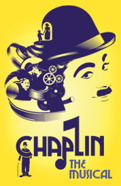Warren Carlyle on Googling Hitler, Falling for the Tramp & Finding the Right Recipe for Chaplin
About the Author:
Warren Carlyle got his start as a dancer, but the British-born performer has since climbed the ladder from associate choreographer of The Producers to director and choreographer of Finian’s Rainbow, Hugh Jackman, Back on Broadway and now, Chaplin. In the new musical, composed by Christopher Curtis with a book by Curtis and Thomas Meehan, the director took a chance on relatively unknown actor Rob McClure as the beloved Tramp. In 2010, Carlyle co-directed an earlier incarnation of the musical at the La Jolla Playhouse, then called Limelight: The Story of Charlie Chaplin, before bringing it to Broadway's Ethel Barrymore Theatre on September 10. But Carlyle’s not finished yet—this season, he will also serve as choreographer for The Mystery of Edwin Drood, as well as A Christmas Story. Below, Carlyle recalls the moment he fell in love with the Little Tramp, and documents the painstaking and often challenging process of bringing legendary screen icon Charlie Chaplin alive on Broadway, “down to the last fingernail.”
![]()
In 2001, I was working with Susan Stroman on The Producers, and I came across Charlie Chaplin’s film The Great Dictator. We were working on “Springtime for Hitler,” and I literally Googled “Hitler” or something crazy like that. The Great Dictator popped up, and I was fascinated. I remember watching the iconic scene where Chaplin is dancing a ballet with a giant globe—I suddenly became aware of how much dance, and possibilities for dance, are inherent in his work. It was my first big realization that Chaplin and his films are something incredibly special.
Cut to 2010: I was co-directing Limelight: The Story of Charlie Chaplin at the La Jolla Playhouse, and I had fallen in love. The production was my first exposure to Christopher Curtis and Thomas Meehan’s great work, and I relished the opportunity to direct a musical with so much imagination and style. I embraced the challenge of taking the greatest film director and star of all time and transforming his life into a theatrical experience. And our star, Rob McClure? It was love at first sight.
One day during early rehearsals at La Jolla, we were taking our first publicity photos of Rob as Chaplin. I had never seen him in full costume and makeup before, and when he walked around the corner as Charlie Chaplin for the first time, it was unbelievable. Unbelievable! He’s incredibly adept, physically. He dances easily, walks a tightrope easily, learns to play the violin easily and roller-skates easily. Plus, Rob has a keen eye—he’s spent many hours studying Chaplin films to dissect his mannerisms, his looks, and his little tics and quirks. Rob is magnificently skilled at recreating the essence of Chaplin’s physicality without copying him.
In Chaplin, when Rob becomes the Little Tramp (my favorite moment in the show), each movement is choreographed precisely…down to the last fingernail. Every twitch, every footstep, every little butt shake, every shoulder lift. We took great pains to coordinate the film projections, the music and the light cues with his movements. The coat has to fit just right and the transition into his Tramp shoes is challenging. But catching his cane is especially difficult—Rob is standing in a very bright sidelight and as he looks directly into the light, a dancer runs by and tosses the cane 10 feet in the air. But I can trust Rob to catch it.
Rob has never once, in this whole process, ever said the word “no.” I’ve asked him to do some pretty crazy things, and he’s never said it once! That’s the old-fashioned definition of a leading man—he’s truly leading the company. I have complete trust in him, because I feel like the two of us are in this together. He’s incredible.
Bringing Chaplin to life onstage has been a slow and painstaking process—but we just kept working at it, through numerous readings and productions. Before opening on Broadway, for instance, we discovered a moment where Chaplin walks a tightrope in his 1928 film The Circus and decided to use it in the musical as a metaphor for his life. We’ve also added more recreations of moments from Chaplin’s iconic films, like The Kid, that we project onstage throughout the show. If you’re telling the story of the most famous movie star in the world, film has to be a key element. There are film sequences in nearly every scene—in some cases it’s just projected scratches on negatives or even little flickers in the background. But there’s film everywhere, even when it’s not immediately apparent to the audience.
I collaborated with the wonderful film and projection designer (and Chaplin fan!) Jon Driscoll on these sequences, which we filmed in a studio downtown. We spent three days doing green screen filming with the cast. We went to work slowly recreating these iconic film moments. We also created new moments—we weren’t just trying to mimic what Chaplin did. We wanted to use his inspiration as a jumping-off point rather than a means to an end.
Chaplin is a bittersweet story—it’s funny, but also incredibly moving. Like making a cake, there can’t be too much sugar, too much flour or too much milk. A story like Chaplin must have the same balance of ingredients. Act I is Charlie Chaplin’s rise to fame, while Act II focuses on the consequences of his success. Act I is full of music and dance, while Act II is more austere. As Chaplin grows up, the show grows up, too, and the style of storytelling changes accordingly. Chaplin is Charlie’s story, and we’ve tried our hardest to capture his point of view and, most importantly, his imagination. It’s the way I hope Chaplin himself would tell it.

